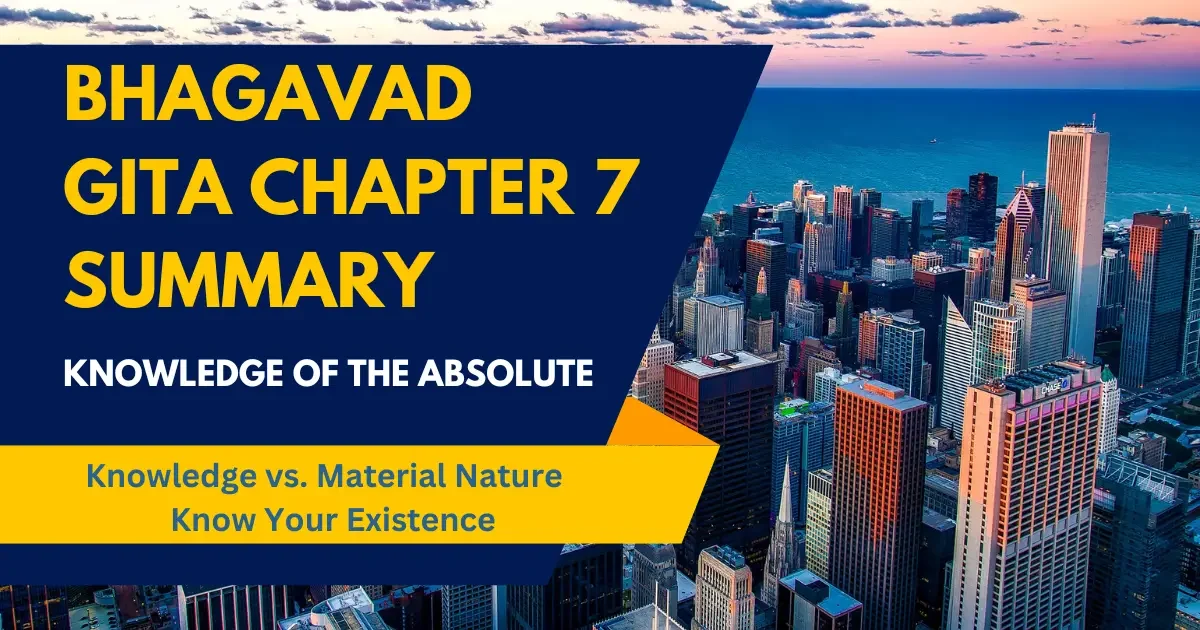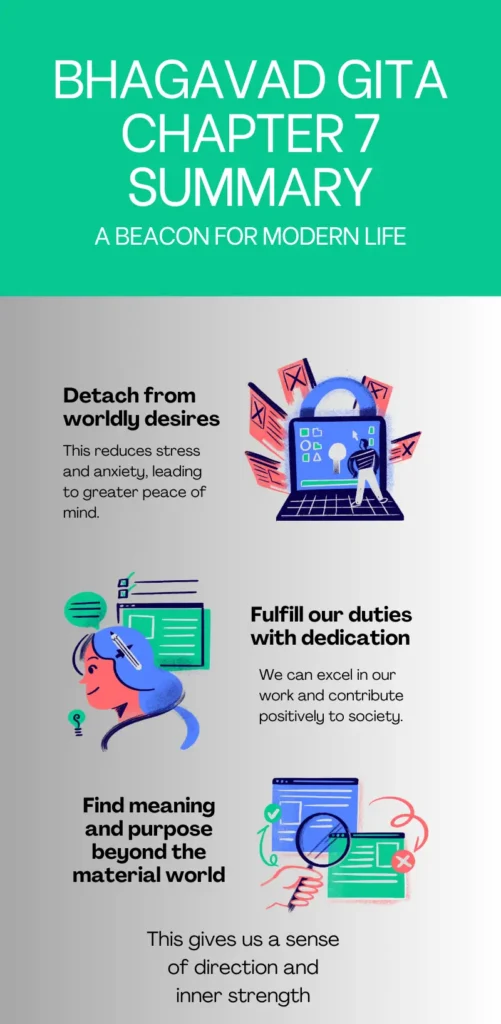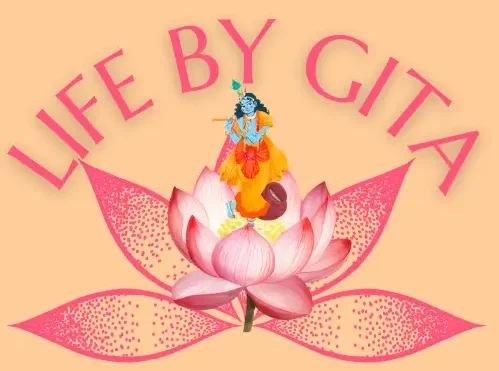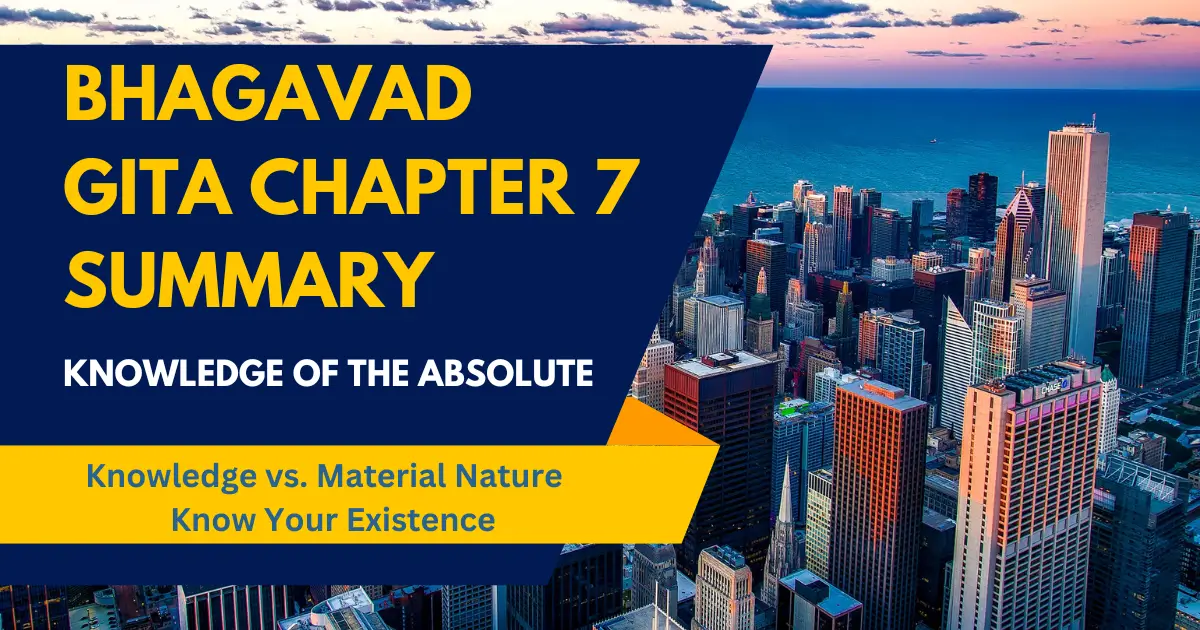
Feeling stressed by the constant hustle? We get it! But what if we told you there’s an ancient text with surprisingly modern advice for finding inner peace? Enter the Bhagavad Gita! Today, we’re cracking open Bhagavad Gita Chapter 7 Summary, a wisdom capsule packed with insights about the universe and your place within it. Let’s dive in and discover how this timeless knowledge can help you navigate the modern world with more clarity and less stress!
1. Introduction
Hello everyone! We’re back, diving deeper into the wisdom of the Bhagavad Gita. In the last chapter, Lord Krishna urged Arjuna to perform his duty (karma) without getting attached to the fruits of his actions. Now, Chapter 7, titled Jñāna Vijñāna Yog or “Knowledge of the Absolute,” unveils some profound truths about the universe and our place within it.
2. Knowledge vs. Material Nature: The Duality of Existence
Chapter 7 throws light on the two fundamental energies of the divine:
- Prakriti (Material Nature): This is the ever-changing, phenomenal world we experience with our senses. It’s the source of all creation and destruction, pleasure and pain.
Here’s a powerful verse (7.4):
“Prakriti is My lower nature; know Me, Paramatma (the Higher Self), to be the other, the higher nature, which pervades this (Prakriti) and sustains all beings.” (Translation adapted from Gita Press)
This verse essentially says that there’s a deeper reality beyond the physical world. It’s like an iceberg – we only see the tip (Prakriti) in our daily lives, but the real foundation lies beneath (Paramatma).
- Purusha (The Eternal Self): This is the unchanging, conscious principle within all living beings. It’s the spark of the divine residing in each of us. Jiva Shakti, the individual soul energy, is the spark of Purusha that resides within each living being. It’s the bridge between the unchanging Self and the ever-changing world.
Understanding these two energies is crucial for navigating life’s complexities. Just like separating milk from water, we need to learn to distinguish between the temporary world (Prakriti) and our eternal Self (Purusha). This distinction empowers us to detach from worldly desires and find lasting peace.
Lord Krishna said in the verse 7.6 that:
“Understand that all living things as born from these two energies of Mine (Lord Krishna as the Supreme God). I am the source of the entire creation, and into Me it will dissolve again.“
Imagine you’re looking at a delicious plate of cookies. All the different flavors, shapes, and sizes come from the same basic dough, right? That dough is like the eternal Self, the unchanging essence of everything. The cookies themselves, with all their variety, are like the ever-changing material world. In the end, both the cookies and the dough are part of the same thing.
3. Facing the Delusions of Maya
The chapter also warns us about Maya, the cosmic illusion that veils our true nature. Maya makes us identify with our temporary body and mind, leading to suffering. But by cultivating wisdom and devotion, we can pierce through this illusion and attain liberation.
Take a look at these verses:
- Verse 7.14:
“My all-encompassing power, the material existence, Maya, with its three faces (goodness, passion, and ignorance), can be a real challenge to see through. But for those who choose to fully trust and surrender to me, overcoming its illusions becomes effortless.“
- Verse 7.18:
“Those who dedicate themselves to Me with unwavering devotion rise above these qualities (of material nature) and become one with the divine, finding inner peace.“
In simpler terms, this verse tells us that while all paths of devotion are valuable, there’s a special place for those who cultivate true knowledge and unwavering devotion to the divine (symbolized here as “Me”). These individuals, with their focused minds and clear purpose, are seen as one with the divine itself.
4. Bhagavad Gita Chapter 7: A Guide for Modern Life
Bhagavad Gita Chapter 7, though composed centuries ago, offers profound wisdom that remains relevant in today’s fast-paced world. By understanding the interplay between Prakriti (material nature) and Purusha (eternal self)/ jīva śhakti (the soul energy), we gain valuable tools for navigating life’s complexities. Here’s how you can apply these ancient teachings to your modern life:
- Reduce Attachment and Find Peace: Chapter 7 encourages us to detach from the transient desires of the material world (Prakriti). This doesn’t mean neglecting your responsibilities, but rather approaching them with a sense of inner peace, knowing your true essence lies beyond worldly pursuits.
- Align with Your Values and Find Purpose: The chapter highlights the importance of understanding your true Self (Purusha). By reflecting on your core values and what brings you a sense of fulfillment, you can align your actions with your inner purpose, leading to a more meaningful life.

5. Conclusion: Bhagavad Gita Chapter 7 Summary
Bhagavad Gita Chapter 7 is more than just ancient philosophy; it’s a practical guide for navigating the complexities of life. As we delve deeper into the remaining chapters, we’ll explore the four Yogic paths in detail, offering even more tools for personal growth. But for now, remember, the key lies in understanding the interplay between the ever-changing world and your eternal Self. By detaching from fleeting desires and aligning yourself with your inner purpose, you can embark on a transformative journey. So, take a deep breath, reflect on the wisdom of Chapter 7, and begin to unveil the radiant light that shines within you.
This is just the beginning of your exploration, and we’re excited to be your guide on this path of self-discovery. Stay tuned for further insights from the Bhagavad Gita!
If you have any question or comment, feel free to leave it in the comment box at the bottom.
Want to read this summary offline? Then, you can download its pdf version below:
Bhagavad Gita Chapter 7 Summary pdf
6. FAQs
- What is the main message of Bhagavad Gita Chapter 7?
The main message is to distinguish between the temporary world (Prakriti) and the eternal Self (Purusha) and pursue a path to liberation.
- How can I apply the teachings of Chapter 7 to my life?
Reflect on the two energies – Prakriti and Purusha. Identify the path that resonates with you and practice its principles in your daily life.
- What is the difference between Purusha and Jiva Shakti?
Purusha is the universal, unchanging conscious principle within all beings. Jiva Shakti, on the other hand, is the individual soul energy that animates each living entity. It’s like a ray of light emanating from the one Purusha, individualized within each being.
Further Reading
Holy Bhagavad Gita

